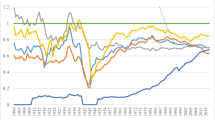Abstract
Following up on the Lewisian theory of development, this chapter traces South Korea’s (hereafter referred to as Korea) economic development to determine the timing of the turning point that dissolved its dual economy, and it analyzes the subsequent influences on income distribution.
Access this chapter
Tax calculation will be finalised at checkout
Purchases are for personal use only
Preview
Unable to display preview. Download preview PDF.
Similar content being viewed by others
References
Bai, M. K. (1982) “The Turning Point in the Korean Economy,” Developing Economies , Vol. 20, No. 2 (January).
Das, D. K. (1992) Korean Economic Dynamism (London: Macmillan).
Hwang, I. J. (1980) The Comprehensive Rural Development: An Assessment and Perspective of Saemaeul Undong (in Korean) (Seoul: Korea Rural Economic Institute).
Joo, H. J. (1979) The Income Distribution and Its Determining Factors in South Korea, Vol. 1 (in Korean) (Seoul: Korea Development Institute).
Joo, H. J. and J. H. Yoon (1984) “The Forecast of Class-Based Income Distribution and Variable Factors” (in Korean), KDI Journal of Economic Policy , Vol. 6, No. 1 (March).
Kim, C. N. (1983) “Economic Development and Labor Market in the Republic of Korea” (in Japanese), Asian Studies , Vol. 30, No. 2 (July).
Kim, C. N. (1985) “Industrialization and Employment in Selected Asian Developing Countries,” in M. K. Bai and C. N. Kim (eds), Industrial Development and Structural Changes in Labor Market: Korea and Southeast Asia (Tokyo: Institute of Developing Economies).
Kim, C. N. (1986) “Industrial Sector Labor Absorption and Migration in Asian Countries” (in Japanese), Southeast Asian Studies , Vol. 24, No. 1 (June).
Kim, C. N., H. Kajiwara and T. Watanabe (1984) “A Consideration of the Compressed Process of Agricultural Development in the Republic of Korea,” Developing Economies , Vol. 22, No. 2 (June).
Kim, C. N. and D. W. Moon (2006) South Korea: Long-term Economic Statistics in East Asia (in Japanese) (Tokyo: Keiso Shobo).
Kim, C. N. and T. Watanabe (1997) The Development of the Contemporary Korean Economy (in Korean) (Seoul: Yoopung Publishing Co. Ltd).
Kim, M. S. et al. (1980) The Modernization of the South Korean Agriculture (in Korean) (Seoul: Korea Rural Economic Institute).
Koh, Y. S. (2011) The Change of Distribution Structure and Directions for Social Policy, Vol. 1 (in Korean) (Seoul: Korea Development Institute).
Kuznets, S. (1955) “Economic Growth and Income Inequality,” The American Economic Review , Vol. 45, No. 1 (March), reprinted in S. Kuznets (1965) Economic Growth and Structure, Selected Essays (London: Heineman Education Books).
Kwon, S. W., I.D. Ko, K.Y. Kim, and S.U. Kim (1992) The Status of the Inequality of Income Distribution and Major Policy Task (in Korean) (Seoul: Korea Development Institute).
Minami, R. (1970) The Turning point in the Japanese Economy (in Japanese) (Tokyo: Sobunsha).
Minami, R. (1973) The Turning Point in Economic Development: Japan’s Experience (Tokyo: Kinokuniya).
Minami, R. (1998) “Economic Development and Income Distribution in Japan: An Assessment of the Kuznets Hypothesis,” Cambridge Journal of Economics , Vol. 22, No. 1 (January).
Minami, R. (2002) The Development of the Japanese Economy (in Japanese) (Tokyo: Toyo Keizai Shimposha).
Editor information
Editors and Affiliations
Copyright information
© 2014 Chang Nam Kim
About this chapter
Cite this chapter
Kim, C.N. (2014). Structural Change of the Labor Market and the Turning Point in South Korea. In: Minami, R., Makino, F., Kim, K.S. (eds) Lewisian Turning Point in the Chinese Economy. Palgrave Macmillan, London. https://doi.org/10.1057/9781137397263_3
Download citation
DOI: https://doi.org/10.1057/9781137397263_3
Publisher Name: Palgrave Macmillan, London
Print ISBN: 978-1-349-48485-0
Online ISBN: 978-1-137-39726-3
eBook Packages: Palgrave Economics & Finance CollectionEconomics and Finance (R0)




